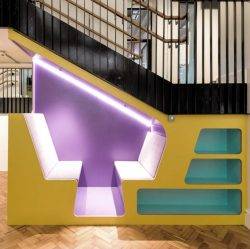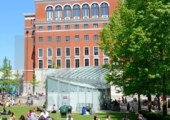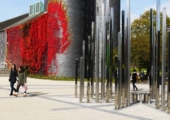 Insight into the way things work can often come from the strangest and most difficult places. For Jill Bolte Tayor, a neuroscientist well versed in the theory of how the brain works, her particular insight into the practical functioning of the brain came as a result of a stroke she suffered in 1996. What she learned during and after her experience became the subject of a famous Ted Talk in 2008.
Insight into the way things work can often come from the strangest and most difficult places. For Jill Bolte Tayor, a neuroscientist well versed in the theory of how the brain works, her particular insight into the practical functioning of the brain came as a result of a stroke she suffered in 1996. What she learned during and after her experience became the subject of a famous Ted Talk in 2008.
It’s worth watching the whole talk, but early on she describes what she learned about the way the brain processes information, in particular the distinction between the way the left and right hemispheres function. An abridged version of what she describes follows:
[perfectpullquote align=”right” bordertop=”false” cite=”” link=”” color=”” class=”” size=””]Because they process information differently, each of our hemispheres think about different things, they care about different things, and they have very different personalities[/perfectpullquote]
For those of you who understand computers, our right hemisphere functions like a parallel processor, while our left hemisphere functions like a serial processor. The two hemispheres do communicate with one another through the corpus callosum, which is made up of some 300 million axonal fibres. But other than that, the two hemispheres are completely separate. Because they process information differently, each of our hemispheres think about different things, they care about different things, and, dare I say, they have very different personalities.
Our right human hemisphere is all about this present moment. It’s all about “right here, right now.” Information, in the form of energy, streams in simultaneously through all of our sensory systems and then it explodes into this enormous collage of what this present moment looks like, what this present moment smells like and tastes like, what it feels like and what it sounds like.
Our left hemisphere is a very different place. Our left hemisphere thinks linearly and methodically. Our left hemisphere is all about the past and it’s all about the future. Our left hemisphere is designed to take that enormous collage of the present moment and start picking out details, and more details about those details. It then categorises and organises all that information, associates it with everything in the past we’ve ever learned, and projects into the future all of our possibilities.
A workplace parallel
The way we store and use information and things in the workplace exhibits a similar dichotomy. We might term them the difference between storage and stowage.
Storage is the equivalent of the left hemisphere. It is methodical and focuses on what has gone before. It is the core of information we use to plan the future. It is the things we file away and archive so we know how to find them at some possibly undetermined point in the future. It is categorised. It may never be used but we keep it just in case and based on our experiences of discarding information for which we may never foresee a use. In a business context, it is often shared and available to all. It is typically kept in one place, even if that places is increasingly The Cloud.
Stowage on the other hand is all about the now. It is about the things we need today or tomorrow. It is the stuff that energises our working day and makes it possible. It may not even be information, but the personal items and paraphernalia we need or which make our working day better and more productive. It is also the stuff that allows us to work anywhere and at any time.
The distinction is important in the contemporary workplace because we are seeing a profound shift away from storage to stowage. Storage is increasingly available to us in digital form, but stowage incorporates by definition the physical items we need to work. This trend from one form to the other will continue as work becomes more agile in response to profound technological and cultural change. We may welcome the ability to work anywhere, but we still need a place to go and a place to keep things. The dichotomy exists but the balance between its two sides is shifting in the workplace.
______________________________________
Helen Owen is the Marketing Director of Bisley.















May 23, 2019
From storage to stowage: what neuroscience teaches us about work
by Helen Owen • Comment, Workplace design
It’s worth watching the whole talk, but early on she describes what she learned about the way the brain processes information, in particular the distinction between the way the left and right hemispheres function. An abridged version of what she describes follows:
[perfectpullquote align=”right” bordertop=”false” cite=”” link=”” color=”” class=”” size=””]Because they process information differently, each of our hemispheres think about different things, they care about different things, and they have very different personalities[/perfectpullquote]
For those of you who understand computers, our right hemisphere functions like a parallel processor, while our left hemisphere functions like a serial processor. The two hemispheres do communicate with one another through the corpus callosum, which is made up of some 300 million axonal fibres. But other than that, the two hemispheres are completely separate. Because they process information differently, each of our hemispheres think about different things, they care about different things, and, dare I say, they have very different personalities.
Our right human hemisphere is all about this present moment. It’s all about “right here, right now.” Information, in the form of energy, streams in simultaneously through all of our sensory systems and then it explodes into this enormous collage of what this present moment looks like, what this present moment smells like and tastes like, what it feels like and what it sounds like.
Our left hemisphere is a very different place. Our left hemisphere thinks linearly and methodically. Our left hemisphere is all about the past and it’s all about the future. Our left hemisphere is designed to take that enormous collage of the present moment and start picking out details, and more details about those details. It then categorises and organises all that information, associates it with everything in the past we’ve ever learned, and projects into the future all of our possibilities.
A workplace parallel
The way we store and use information and things in the workplace exhibits a similar dichotomy. We might term them the difference between storage and stowage.
Storage is the equivalent of the left hemisphere. It is methodical and focuses on what has gone before. It is the core of information we use to plan the future. It is the things we file away and archive so we know how to find them at some possibly undetermined point in the future. It is categorised. It may never be used but we keep it just in case and based on our experiences of discarding information for which we may never foresee a use. In a business context, it is often shared and available to all. It is typically kept in one place, even if that places is increasingly The Cloud.
Stowage on the other hand is all about the now. It is about the things we need today or tomorrow. It is the stuff that energises our working day and makes it possible. It may not even be information, but the personal items and paraphernalia we need or which make our working day better and more productive. It is also the stuff that allows us to work anywhere and at any time.
The distinction is important in the contemporary workplace because we are seeing a profound shift away from storage to stowage. Storage is increasingly available to us in digital form, but stowage incorporates by definition the physical items we need to work. This trend from one form to the other will continue as work becomes more agile in response to profound technological and cultural change. We may welcome the ability to work anywhere, but we still need a place to go and a place to keep things. The dichotomy exists but the balance between its two sides is shifting in the workplace.
______________________________________
Helen Owen is the Marketing Director of Bisley.